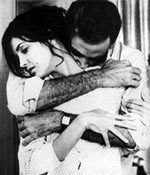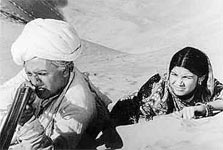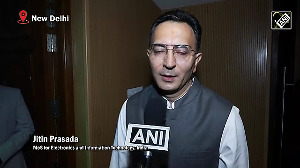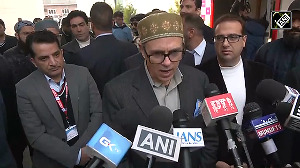 It apparently has become a staple of the season in Thiruvanathapuram -- a little winter fog, a much-hyped Grand Kerala Shopping Festival (as though the wall-to-wall, year-round ads on TV for gold and women's clothes were not enough), large numbers of black-clad Ayyappa pilgrims, and now armies of cineastes armed with the signature black bags of the International Film Festival.
It apparently has become a staple of the season in Thiruvanathapuram -- a little winter fog, a much-hyped Grand Kerala Shopping Festival (as though the wall-to-wall, year-round ads on TV for gold and women's clothes were not enough), large numbers of black-clad Ayyappa pilgrims, and now armies of cineastes armed with the signature black bags of the International Film Festival.
This year I too joined the quasi-pilgrimage to my own home-town, and so far I have been pleasantly surprised by the festival's logistics and films.
In general, nothing works well in Kerala, so one has relatively poor expectations; and compared to that, the International Film Festival of Kerala 2009 (IFFK), which kicked off on December 11 and will come to a close on December 18, is unusual: things seem to work like clockwork. I was able to register online, and the person on the phone when I called was quite helpful: "Just come to the media cell and ask for me, my name is Walter".
Sure enough it took me all of five minutes to get my pass: Walter had it ready for me complete with my photograph, identity number and password. Amazing; my jaw practically hit the floor.
Wonder of wonders, I can even reserve a balcony seat for a show by sending an SMS. They are also sending out SMS announcements of changes in schedule. The films I attended actually started on time, there were practically no cellphones going off, and the shows I attended was not crowded, even though there are some 9,000 delegates. Altogether, a pleasant experience.
People have told me this is the best film festival in India, and I can well believe it. At first glance, the selection of films is quite overwhelming -- there are over 160 films being shown over eight days in as many as nine theatres, so it is a little hard to pick and choose, especially when two films you pick may be running simultaneously. I have been told that much of the credit for the good selection goes to the artistic director of the festival, Bina Paul. Good for you, Bina.
It does make a certain sense that Thiruvanathapuram would be a good locale for a regular film festival -- this is the 14th annual version of the IFFK. In this compact town, the nine theatres are all within a short rickshaw ride of each other. It is not an expensive place, so that even penurious cineastes can find food and lodging for relatively little money; and even the autorickshaw guys don't seem to be fleecing festival-goers too much.
There is a strong film culture, engendered by a strong literary culture in Malayalam, which has produced outstanding directors such as that genius and mystic of cinema, the last G Aravindan, the master of the medium Adoor Gopalakrishnan, cinematographer-turned-filmmaker Shaji N Karun, and numerous others. Malayalam consistently produces some of the best contemporary films in India.
There are also many film societies, including Surya, which runs an annual 111-day cultural festival; Chitralekha, started by Adoor Gopalakrishnan, and a number of others. There seem to be many young fans -- especially of the sling-bag variety -- who are knowledgeable about world cinema. And even the festival handbook and the screening schedule are well-produced, tightly written, and easy to navigate.
Naturally, in this bastion of leftist thought, the selection of films reflects left-liberal groupthink. They have rolled out the usual suspects who populate these festivals and pontificate; some of the films also flog the same old tired cliches. But that is no reason to not enjoy some of the good pictures available.
All in all, this is quite a treat. With a single pass, I can attend as many shows as I wish -- a far cry from waiting for hours for tickets for individual films in Chennai when I was a student, and finally sweet-talking friendly girls in the much shorter women's queue to get us also tickets. And then being stunned by Aravindan's Kanchana Sita, which requires at least two or three viewings and much rumination.
On the first day of the festival, there was the brilliant South African film, Jerusalema (2008), which is notable for its energy and for its tautly controlled violence. In telling the fictionalized true story of a minor thug, Lucky Kunene, who transforms himself into a rich slumlord, it is following in the path of similar films such as the Tamil Nayagan, about a true-to-life Mumbai crime-lord.
I did not see this at the IFFK, but I had already seen it in elsewhere. I thought it a riveting film: there was economy in the way the Kunene character, charismatic and thoughtful, grew from a car-jacker to a driver of an illegal taxi to the owner of several apartment blocks under the rubric of the Hillbrow people's housing society. In effect, he steals the buildings from their white owners through borderline legal maneuvers and brutal suppression of foes; and it is hard to sympathize with the erstwhile owners.
Along the way, he acquires a white, liberal, Jewish wife, whose brother, a junkie, he rescues from the clutches of drug-runners. But retribution catches up with him in the form of a resolute, relentless Inspector Jauvert-like police officer, who methodically hunts him down. He is jailed, and there is no escape for him. Or is there?
On the second day, I saw two old movies, Memories of Underdevelopment (1968), a classic black-and-white film by Cuba's Tomas Gutierrez Alea, and Mrinal Sen's Bhuvan Shome (1969), which is famous for having kicked off India's New Wave. They were an interesting study in contrast, and curiously intertwined in several ways. I am glad I was able to see them in juxtaposition.
Memories of Underdevelopment is one of the greatest films ever to come out of Cuba, and shows a mature and sophisticated sensibility. Set in 1962, in the aftermath of the communist takeover, the Bay of Pigs invasion by Cuban exiles, and in the background of the Cuban missile crisis, it is a very European film, and is a nice counterpoint to the French New Wave films (Jules et Jim, etc.) here.
Havana in 1962 is strangely European: a tropical Paris. The protagonist, Sergio, is a 38-year-old upper-crust white man ("bourgeois" according to the IFFK handbook!) whose parents and wife have moved on to Miami, which a lot of wealthy whites did after Fidel Castro came to power overthrowing the Batista government. Sergio, however, decides to stay on, and the film is a metaphor for the mixed feelings Cubans have about the revolution and about their lives in changing times.
Remarkably for a committed communist, Alea is ambivalent about the after-effects of the revolution, as is his hero. Sergio looks out over the beachfront and the magnificent monuments of old Havana from his comfortable high-rise apartment, and reflects on the changes that have taken place. Alea is telling us the promised millennium has not quite arrived after Castro took charge. In fact, the American embargo is already beginning to bite, and the handsome cars cannot get parts or even oil.
The film splices in what appears to be real-life documentary footage about individuals in the American-instigated Bay of Pigs contingent: a priest, a torturer, a philosopher, et al. They do not come across very well, and that is probably one of the reasons this film was banned in the US.
Sergio spends much time fantasizing about attractive young women, for instance his maid, who, strangely enough, is a baptized Protestant in a Catholic country. And he is constantly on the lookout for young women, perhaps to compensate for his wife leaving him.
The soundtrack reflects Sergio's fears about ageing, for which he blames the tropical climate: "Everything ripens and decays quickly. There is an exquisite moment between 30 and 35 when women change from being beautiful to being exhausted".
The soundtrack plays recurring themes from Vivaldi's Four Seasons, Spring when Sergio remembers his beautiful girlfriend, Hanna, from his teenage years; and Autumn when he goes through a mid-life crisis and seduces the 17-year-old Elena. There is a subtle theme about class and race in Cuba: Sergio is white, while Elena and her family have more obviously Native American features.
Oddly enough, Sergio, who is accused of statutory rape of the minor Elena, is acquitted of the crime: It appears as though the director is acquitting the white upper class in the crime of raping Cuba's native culture. Remarkable if he is actually suggesting that the decadent Batista regime and the revolutionaries are equally culpable.
Sergio takes Elena on an extended tour of Ernest Hemingway's old study, where the writer worked on "The short, happy life of Francis Macomber", and so forth. But he believes that Hemingway had no choice that he had to commit suicide, perhaps much like Cuba itself is doing.
The film ends in the aftermath of the Cuban Missile Crisis, with US president John Kennedy's voice crackling over the radio, threatening an invasion. Sergio anxiously scans the horizon with the telescope, as workers set up anti-aircraft guns atop nearby apartment buildings.
This is a deep and insightful film, richly deserving of the accolades it has received.
 The next film I saw was the classic Bhuvan Shome, also dating back to 1969, and much-praised as the harbinger of the New Wave to India. I have seen a number of Mrinal Sen films in the past, such as Calcutta 71, Akaler Sandhaney, etc., and I was keen on seeing this original masterpiece, which also won a Grand Prize at the Venice Festival. Unfortunately, I was underwhelmed by the film, although it did improve dramatically towards the end.
The next film I saw was the classic Bhuvan Shome, also dating back to 1969, and much-praised as the harbinger of the New Wave to India. I have seen a number of Mrinal Sen films in the past, such as Calcutta 71, Akaler Sandhaney, etc., and I was keen on seeing this original masterpiece, which also won a Grand Prize at the Venice Festival. Unfortunately, I was underwhelmed by the film, although it did improve dramatically towards the end.
First, it did not have subtitles, which I think is unfair to viewers at a festival like this: and surely, there must be a print of Bhuvan Shome out there with English subtitles. Furthermore, there was no warning in the programme (some films were marked 'No EST'). This made it hard for me to follow, as I had to make do with my rusty Hindi -- and in any case some of the dialogue was in some Gujarati dialect; all the jokes went over my head.
Second, I was appalled by the early scenes: an extended bullock-card ride with an apparently drunken Saurashtran driver, and a long encounter with an irate buffalo. This was plain slapstick; Sen seems to have a weakness for burlesque-like silliness, as I remember from his other films, and this detracts from the serious themes he touches on. About half an hour of this stuff could easily be cut out, and the film would improve dramatically. Similarly, I found the ponderous voice-over by one Amitabh annoying. I was pleased, though, to recognize Sadhu Meher, whom I remember from his later role in Ankur.
The latter scenes in the film, once the stiff disciplinarian Mr Shome meets the charming young village woman Gouri, who takes him duck-hunting, are engaging and well done. The gradual change in the fifty-ish and widowed Shome, who is surprised and pleased by how she treats him respectfully yet playfully as she might a favorite uncle, is beautifully brought out by veteran actor Utpal Dutt; Suhasini Mulay turns in a superlative performance as Gouri.
There is even a hint that Shome is attracted to Gouri; unlike the rakish Sergio, of course he does not make any advances - after all, this is an Indian film. But she does awaken his finer, more sensitive side, and he goes back to his job a rejuvenated, even playful man, no longer the martinet he was.
Yes, the film gets vastly better in the second half, but I am at a loss as to why it is considered so epoch-making. After all, Satyajit Ray had already ushered in the era of stark realism with the superlative Apu trilogy; and indeed his masterwork, the gem-like Charulata had appeared by 1964. A conjecture: did Bhuvan Shome get all these kudos because it was the first New Wave film in Hindi, and not the first Indian New Wave film?
The soundtrack too disappointed. It was too loud and raucous in parts (deafening train ride and bullock-cart ride, for instance), and added little to the flow, except where there was a half-heard thumri (I presume) in the abandoned palace, when Shome and Gouri look out over the marshes where the migratory birds are massing.
Overall, this was a let-down for a film that I had anticipated for so long, having seen a whole slew of better New Wave films, including Ray's Calcutta trilogy and Aranyer Din Ratri, Sen's own Akaler Sandhaney, Chomana Dudi and Vamsa Vrksha in Kannada, Kanchana Sita by Aravindan and Kodiyettam by Adoor in Malayalam, Nishant, Uski Roti, Aakrosh, Garam Hawa, etc. in Hindi, among others.
On day three, I saw two films: one a 2009 Uruguyan film by Alvaro Brechner, Bad day to go fishing, a slight but reasonably entertaining film that reminded me of buddy movies like Midnight Cowboy or even Of Mice and Men.
The impresario Orsini, a small-time con-man, likes to travel to small Latin American cities with his friend, the aging wrestler von Oppen, with an open challenge to all comers -- anybody who can last three minutes in the ring with the wrestler will get $1000. Of course, Orsini doesn't have the $1000, and he hopes to clean up by selling lots of tickets to the local yokels.
A straightforward tale of a con, where a 'challenger' is paid off to take a fall; however there is a twist in the tale. Nevertheless, a rather pedestrian offering, pleasant enough but not deep enough to warrant much analysis.
The same could be said of the second film I saw on day 3: Tales from a Golden Age (Romania, 2009), a collection of five short films put together by Cristian Mungu.
The tales are darkly humorous stories of the travails of ordinary people under the brutally oppressive Ceausescu regime. It was good to see that it is not only in India that ordinary middle-class people have lived bizarre lives, forced to barter and steal just to feed themselves.
While the stories were fairly clever and funny, the direction was, once again, rather pedestrian. There were occasional guffaws from the audience at the broad humour and the sly titles that refer to various urban legends that inspired the satire here. However, after the first two episodes the gallows humour began to pale from over-exposure, and I preferred to go home rather than wait out the other three episodes in this 155-minute (that's two and a half hours plus) film.
It is curious and even charming that a film denouncing a communist regime would make it out of Romania, and that it would be shown at the IFFK, considering it is in Kerala. Nevertheless, once the novelty of this fact wore off, the film itself was too slight to keep one's attention.





